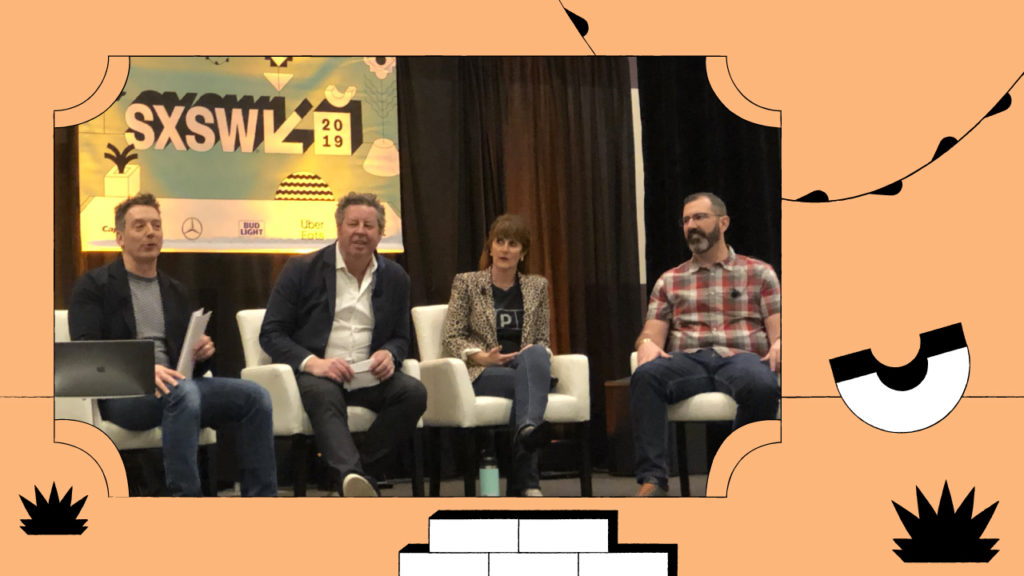With comScore predicting that voice search on the web will be 50 percent of all searches in the next few years, brands are discussing how to carve out a sonic niche in an increasingly noisy environment.
That was the core of the conversation at Saturday’s SXSW panel, ‘The Invisible Brand in an Audio-First World,’ moderated by Man Made Music’s Joel Beckerman and including chief marketing officer for NPR Meg Goldthwaite, Citi’s managing director of global branding, media and marketing Mark Ingall and Matthew Benson, advanced innovation lead at Faurecia.
According to Beckerman, “audio-first media is exploding: devices, immersive spaces, smart speakers like Alexa, while traditional media like television and radio is in decline.”
“As technology becomes more and more intertwined in our lives, the winners will be the brands that humanize technology while getting credit for every aspect of their role in experiences and products humans love,” said Beckerman.
But it’s not that sonic logos and audio branding are necessarily new; you can hear it in the soft hum of HBO’s opening to the satisfying ‘swoosh’ of an email being sent. However, there’s a renewed focus for brands to lay the groundwork for a future where most consumers interact solely through voice technology and to do so in a way that’s sensible for the consumer interaction in question.
For NPR, sound is part and parcel of its storytelling and brand identity. CMO Meg Goldthwaite put it like this: “It’s the play on sound that is what we want to do as marketers because that’s what we’re trying to elicit: emotions that are affiliated with the brand.” “We’re sort of tied to this old-timey device of a radio,” said Goldthwaite. “Radio has been purported to be dead for quite a long time. It’s my job as the chief marketing officer to that people know that NPR isn’t just radio.”
“My challenge is that as our content gets disaggregated, and you’re not just hearing [. . .] “This is NPR,” before every bit of audio, it’s trying to find a way to brand our audio and make certain that people understand that what they’re about to hear is good, quality sound: that sound that has made NPR the most loved and most trusted for over 50 years.”
Mark Ingall of Citi has a different challenge: how do you sonically translate feelings of security and trust while providing consumer touchpoints that are sensible for a banking company?
“Sometimes the best sound for a customer is no sound,” said Ingall. “There’s a fascinating thing where people would rather interact with machines than they would persons [. . .] It’s only when you’ve got a problem and you want someone to scream at.”
“What you don’t want to hear is when people make a mistake [. . .] that ‘BZZZ’ sound.” That audio cue can make the difference between punishing or rewarding a consumer for their transaction.
Whatever the touchpoint, Ingall’s priority remains the same: “How can we make people feel comfortable about their money [. . .] how can we make sure we’re present in that transaction?”
“If you’ve signed up to get stuff from us, that email push sound feels like us as well. It doesn’t sound like Apple, it doesn’t sound like Chase, it doesn’t sound like anyone else. You know that it’s Citi that’s actually giving you something.”
“When you transact on our app, what we’re looking for is that you’re reassured that that action has gone through and what you intended to happen has happened.”
Beckerman concluded with a few statistics: “If you like the sound in association with a particular experience, you’re 86 percent more likely to actually want to have that experience again with that brand [. . .] If you’re doing a step-by-step process to fix something, scored experiences actually help people. It’s 20 percent more likely that you’ll find that experience fast or easy and it’s 32 percent more likely you’ll want to have that experience again. These things actually have data-points which can monetize across experience.”

